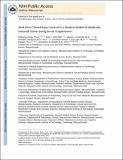| dc.contributor.author | Liberman, Max Y. | |
| dc.contributor.author | Chemali, Jessica J. | |
| dc.contributor.author | Westover, M. Brandon | |
| dc.contributor.author | Kenny, Jonathan D. | |
| dc.contributor.author | Solt, Ken | |
| dc.contributor.author | Purdon, Patrick Lee | |
| dc.contributor.author | Ching, Shinung | |
| dc.contributor.author | Brown, Emery Neal | |
| dc.date.accessioned | 2016-05-02T13:18:39Z | |
| dc.date.available | 2016-05-02T13:18:39Z | |
| dc.date.issued | 2013-10 | |
| dc.identifier.issn | 0003-3022 | |
| dc.identifier.uri | http://hdl.handle.net/1721.1/102344 | |
| dc.description.abstract | Background:: A medically induced coma is an anesthetic state of profound brain inactivation created to treat status epilepticus and to provide cerebral protection after traumatic brain injuries. The authors hypothesized that a closed-loop anesthetic delivery system could automatically and precisely control the electroencephalogram state of burst suppression and efficiently maintain a medically induced coma.
Methods:: In six rats, the authors implemented a closed-loop anesthetic delivery system for propofol consisting of: a computer-controlled pump infusion, a two-compartment pharmacokinetics model defining propofol’s electroencephalogram effects, the burst-suppression probability algorithm to compute in real time from the electroencephalogram the brain’s burst-suppression state, an online parameter-estimation procedure and a proportional-integral controller. In the control experiment each rat was randomly assigned to one of the six burst-suppression probability target trajectories constructed by permuting the burst-suppression probability levels of 0.4, 0.65, and 0.9 with linear transitions between levels.
Results:: In each animal the controller maintained approximately 60 min of tight, real-time control of burst suppression by tracking each burst-suppression probability target level for 15 min and two between-level transitions for 5–10 min. The posterior probability that the closed-loop anesthetic delivery system was reliable across all levels was 0.94 (95% CI, 0.77–1.00; n = 18) and that the system was accurate across all levels was 1.00 (95% CI, 0.84–1.00; n = 18).
Conclusion:: The findings of this study establish the feasibility of using a closed-loop anesthetic delivery systems to achieve in real time reliable and accurate control of burst suppression in rodents and suggest a paradigm to precisely control medically induced coma in patients.
A closed-loop anesthesia delivery system using a computer-controlled infusion of propofol can achieve a reliable and accurate real-time control of burst suppression in rats. | en_US |
| dc.description.sponsorship | National Institutes of Health (U.S.) (Grant DP1-OD003646) | en_US |
| dc.description.sponsorship | National Institutes of Health (U.S.) (Grant ROI-GM10498) | en_US |
| dc.description.sponsorship | National Institutes of Health (U.S.) (Grant DP2-OD006454) | en_US |
| dc.language.iso | en_US | |
| dc.publisher | Ovid Technologies (Wolters Kluwer) - Lippincott Williams & Wilkins | en_US |
| dc.relation.isversionof | http://dx.doi.org/10.1097/ALN.0b013e31829d4ab4 | en_US |
| dc.rights | Creative Commons Attribution-Noncommercial-Share Alike | en_US |
| dc.rights.uri | http://creativecommons.org/licenses/by-nc-sa/4.0/ | en_US |
| dc.source | PMC | en_US |
| dc.title | Real-time Closed-loop Control in a Rodent Model of Medically Induced Coma Using Burst Suppression | en_US |
| dc.type | Article | en_US |
| dc.identifier.citation | Ching, ShiNung, Max Y. Liberman, Jessica J. Chemali, M. Brandon Westover, Jonathan D. Kenny, Ken Solt, Patrick L. Purdon, and Emery N. Brown. “Real-Time Closed-Loop Control in a Rodent Model of Medically Induced Coma Using Burst Suppression.” Anesthesiology 119, no. 4 (October 2013): 848–860. | en_US |
| dc.contributor.department | Massachusetts Institute of Technology. Institute for Medical Engineering & Science | en_US |
| dc.contributor.department | Harvard University--MIT Division of Health Sciences and Technology | en_US |
| dc.contributor.department | Massachusetts Institute of Technology. Department of Brain and Cognitive Sciences | en_US |
| dc.contributor.department | Picower Institute for Learning and Memory | en_US |
| dc.contributor.mitauthor | Ching, ShiNung | en_US |
| dc.contributor.mitauthor | Solt, Ken | en_US |
| dc.contributor.mitauthor | Purdon, Patrick Lee | en_US |
| dc.contributor.mitauthor | Brown, Emery N. | en_US |
| dc.relation.journal | Anesthesiology | en_US |
| dc.eprint.version | Author's final manuscript | en_US |
| dc.type.uri | http://purl.org/eprint/type/JournalArticle | en_US |
| eprint.status | http://purl.org/eprint/status/PeerReviewed | en_US |
| dspace.orderedauthors | Ching, ShiNung; Liberman, Max Y.; Chemali, Jessica J.; Westover, M. Brandon; Kenny, Jonathan D.; Solt, Ken; Purdon, Patrick L.; Brown, Emery N. | en_US |
| dc.identifier.orcid | https://orcid.org/0000-0001-5328-2062 | |
| dc.identifier.orcid | https://orcid.org/0000-0001-5651-5060 | |
| dc.identifier.orcid | https://orcid.org/0000-0003-2668-7819 | |
| mit.license | OPEN_ACCESS_POLICY | en_US |
